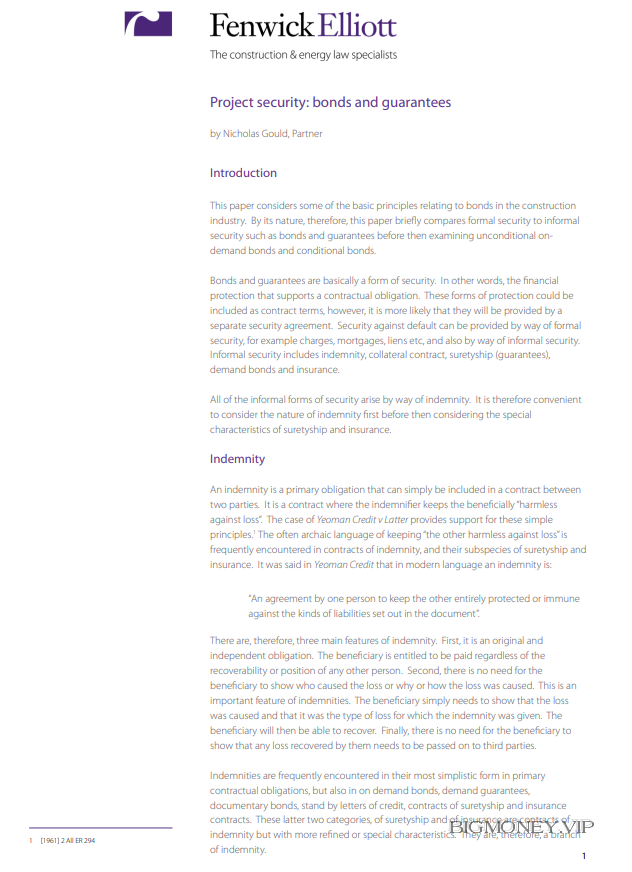Project security: bonds and guarantees by Nicholas Gould, Partner

Contractual indemnities
A simple contractual indemnity is a primary obligation arising between two people. A
simple indemnity clause might state that one party “agrees to indemnify you if you suffer
damage as a result of my negligence”. Contractual indemnities might also arise in the
form of collateral contracts. These might simply be as a result of an assurance given
which then induces a contract.
In terms of more frequently encountered security, we are concerned with formal
contracts that are ancillary to the primary contract. Common forms of ancillary or
collateral contract include collateral warranties (duty of care deeds) or direct step-in
agreements given to funders. They could also include letters of intent or letters of
comfort.
Insurance
It is worth mentioning insurance before moving on to consider suretyship and in
particular bonds. This is because insurance is a type of indemnity contract. It arises from
a primary obligation whereby the insurer indemnifies the insured against loss caused by
a speci! ed insurance risk. A breach of contract is not required in order for the insured
to recover under the insurance policy. However, there are special characteristics of
contracts of insurance, such as a duty of utmost good faith, and the requirement for the
beneficiary to have an insurable interest.
Suretyship
A surety is a guarantor. A surety or guarantor is someone who contracts with an actual
or potential creditor of another so as to be responsible to that creditor by way of security
for all or part of the debt. The key characteristic of suretyship is that it is collateral to the
main agreement, and is therefore a secondary obligation. A surety cannot be someone
who has become liable in substitution for the liability of another. Neither can a surety be
someone who has joint liability with another.
According to Halsbury’s Laws:
“A guarantee is an accessory contract by which the promisor undertakes to
be answerable to the promisee for the debt, default or miscarriage of another
person, whose primary liability to the promisee must exist or be contemplated.”2
In other words, it’s a secondary obligation or separate contract placing an obligation
on a guarantor to ensure that the principal completes a certain task for a third party
bene! ciary. If the principal fails to carry out that task then it is the guarantor’s obligation
to perform the principal’s task. If the guarantor fails, then the guarantor is liable in
damages.
The liability of a surety or guarantor arises because a material fault has occurred under a
primary underlying contract. This liability under the primary contract must arise before
liability can arise under the second surety contract.
The characteristics of suretyship are:
1. That there are two contracts. A contract of guarantee, and the underlying
primary contract which is to be guaranteed.
2. That there are three parties. The guarantor, beneficiary and contractor. The
guarantor and beneficiary are parties to the contract and the guarantee. The
bene! ciary and the contractor are parties to the underlying primary contract.




